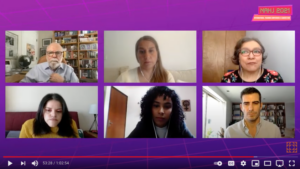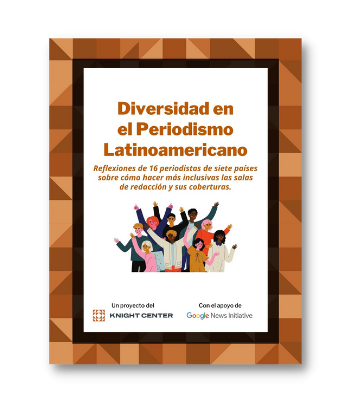Journalism can be a key factor in eradicating deeply rooted problems in Latin America such as discrimination, racism, violence and polarization, but for this, journalists need to incorporate a perspective of diversity and inclusion, both in their narratives and in their newsrooms.
These were the takeaways from Andrea Medina, María Teresa Juárez, Jamile Santana and Eladio González, several of the authors for articles in the ebook in Spanish, "Diversity in Latin American Journalism," which was launched virtually on Saturday, July 17, 2021, during the annual conference of the National Association of Hispanic Journalists (NAHJ).

CW from top R: María Teresa Juárez, Eladio González, Jamile Santana, Andrea Medina, Rosental Alves and Mariana Alvarado.
The presentation was moderated by Professor Rosental Alves, director of the Knight Center for Journalism in the Americas at the University of Texas at Austin, and featured an introduction by Mexican journalist Mariana Alvarado, who served as editor of the ebook
Adopting a diverse and inclusive look in the coverage and dynamics of newsrooms would contribute to a much more democratic dialogue in society, according to María Teresa Juárez, Mexican journalist and scriptwriter, columnist for digital media outlet Pie de Página and member of the board of directors of the organization Periodistas de a Pie.
"Journalism can be a factor of social transformation because we have language in our hands that is the tool that can open doors and transform culturally," said Juárez, who wrote the article "Journalism and the anti-racist agenda: weaving other narratives."
The journalist spoke about how, in recent years, academic and statistical studies have shown that in Mexico skin tone directly influences people's access to better opportunities. Journalism is challenged, she said, to take those findings into account to help stop perpetuating those ideas of superiority based on skin tone.
"We continue to see that in the newsrooms the term 'race' is used as a generic term to refer to the different ethnolinguistic diversities in the world," she said. “Races do not exist, but racism does exist and what better than journalism, which is the vehicle of mass communication through words, images and sounds, to change these narratives that have prevailed not only in Mexico, but in Latin America.”
Media also have the great power to contribute to breaking down stereotypes that affect various sectors of society, said Andrea Medina, who wrote the article "The role of the media in the paradigm shift on disability."
The Chilean journalist wrote in her text about everything that a communicator should know to cover news about people with disabilities and about how to change the welfare and pity approach to a focus that promotes the rights of this population.
Medina, who has experienced being stereotyped for a disability condition firsthand, urged her colleagues to get informed and stop perpetuating stereotypes in the media, as well as to listen directly to people with disabilities to promote their inclusion in society.
"It is important that our voice is heard, not the voice of the family member or the people who take care of us, because who better to give an opinion on what is happening to us?" she said. “That is another message that I want to convey to you in this article: that in addition to generating news from a rights perspective, listen to people with disabilities, include them, generate inclusion. Disability is not given by the health conditions of each person, but by social barriers.”
Another of the sectors that suffer the perpetuation of stereotypes is the LGBT+ community. Journalistic coverage that this group commonly receives in Latin American countries is from approaches of violence, discrimination and homophobia. However, in 2019 the Mexican magazine Expansión contributed to changing that narrative.
The publication, which specializes in business, launched the first list of business executives who were "out of the closet" in Mexico, which contributed to understanding the importance of inclusion in the business world, according to Eladio González, who wrote about this project in the article "The year that Expansión placed LGBT+ inclusion on the Mexican business agenda."
“It has been a very interesting exercise. The first year we could barely reach 40 (executives on the list) and this year the number of candidates we had exceeded 200,” said González, who is the general editor of Expansión. “It has become a reputational issue for companies and a commitment issue for these executives themselves, who believe that, with their visibility, they can make it so the issue of inclusion and diversity is already on the table in business discussions.”
Brazilian journalist Jamile Santana was in charge of the article “Yes, it is possible to measure the construction of diversity and its impact on newsrooms,” in which she spoke about the diversity program promoted by Énois Journalism Laboratory, where she works as a journalism manager.
The program, developed in 2020, selected 10 reporters who were placed in 10 newsrooms with different profiles and in different regions of Brazil in order to build changes that would make each media outlet more representative in its production of journalistic content, in its culture and in its management.
“We share tools so that newsrooms can promote diversity in different ways,” Santana said. “As there is a lot of complexity in promoting diversity, we developed a methodology to monitor newsroom development. It is possible to know which areas deserve more attention so that diversity becomes part of daily life in the newsroom.”
 The organization developed eight steps to achieve diversity in newsrooms of all sizes and created a toolbox to promote diversity on a daily basis in the team and for it to have an impact on audiences and consequently on the sustainability of the medium.
The organization developed eight steps to achieve diversity in newsrooms of all sizes and created a toolbox to promote diversity on a daily basis in the team and for it to have an impact on audiences and consequently on the sustainability of the medium.
“We know that our experiences as Black people, women, trans people have a great impact on the journalistic profession, so it is very important not only to keep these professionals in the newsrooms, but also to accompany them, keep them comfortable in these environments so that they can bring their experiences and share their diversity in journalistic production,” Santana said.
The project included creating a formula to measure newsroom progress toward diversity throughout the program.
"Since the creation of metrics is a trend around the world, newsrooms need to turn to the data to create more accurate and just strategies for journalism to become more representative," Santana said.
The lack of diversity in media content also contributes to the narrative of polarization that Latin American societies are experiencing, since it encourages the formation of radical ideas and hate speech about specific groups.
“Media should not enter to play this game of polarization. As practically everyone in this book says: including diversity in the journalistic narrative and in newsrooms is part of the solution,” González said.
Mariana Alvarado added that it is time for journalism to reach all population groups without exception. And that will only be achieved through a vision of diversity and the creation of more niche media.
"We are all married to the idea that journalism is a public service and our duty as journalists is to reach absolutely everyone," she said. "In that sense, I think it is important that we see inclusion and diversity, not as a fashion, but as something that is here to stay and that must be the beginning of a new era in our great informative work."
Professor Alves thanked NAHJ for providing space for the ebook presentation and recognized the institution's historic struggle for diversity in the U.S. media.
“I believe that in Latin America we have much to learn and seek inspiration from this long experience that journalists have here in the United States for their struggles for civil rights, for diversity, equity and inclusion, these three words that are so great and so important and that are becoming a great cry for social justice in the world,” the professor said.
The ebook, which is available in Spanish and can be downloaded for free at the JournalismCourses.org site, is the culmination of an initiative to support diversity in journalism in Latin America promoted by the Knight Center for Journalism in the Americas, with the support of the Google News Initiative.
The first stage of the initiative was the MOOC (massive, open, online course) "Diversity in News and Newsrooms," taught by Peruvian journalist Marco Avilés in January 2021. This MOOC brought together 1,921 students from 50 countries. This is now available as a self-directed course on JournalismCourses.org.
The second stage was the 1st Latin American Conference on Diversity in Journalism, a virtual event held on March 26 and 27 of the same year, to which 2,120 people registered. The conference can be viewed on YouTube.